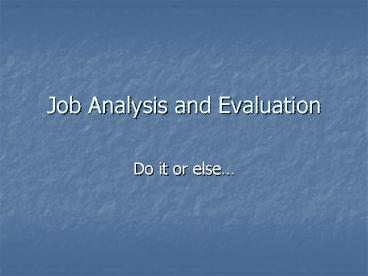Job Analysis and Evaluation - PowerPoint PPT Presentation
1 / 19
Title:
Job Analysis and Evaluation
Description:
The identification of criteria necessary for successful ... equipment manuals. Interview middle managers. pick up lingo. understand job importance acc. ... – PowerPoint PPT presentation
Number of Views:48
Avg rating:3.0/5.0
Title: Job Analysis and Evaluation
1
Job Analysis and Evaluation
- Do it or else
2
Job Analysis
- The identification of criteria necessary for
successful performance in a given job - Identifies KSAs
- Job tasks to perform
- Skills required
- Abilities needed
3
Why Bother??
- The Job Analysis provides the foundation for
almost everything HR is involved in. - Job Descriptions
- Employee Selection
- Training
- Performance Appraisals
- Job Classification
- Job Evaluation
- Job Design
4
Job vs. Worker Oriented Analyses
- Worker-Oriented
- analysis of the skills and abilities required
- intelligent
- self-motivated
- able to work alone
- able to integrate diverse information
- good long-term memory
- time-management skills
- Job-Oriented
- analysis of tasks necessary to complete the job
- more concrete
- e.g. college student
- attend lectures
- take notes
- read text
- write papers
- do homework
5
Sources of Job Information
- SMEs (Subject Matter Experts)
- people who have in-depth knowledge of specific
job under analysis, job skills, and abilities - Job Incumbent
- Supervisors
- Job Analyst
6
Methods of Job Analysis
- Interviews
- Structured Questionnaire / Inventory
- Direct Observation
- Logbooks / Work Diaries
7
Interviews
- Most commonly used method
- very adaptable
- Usually conducted with
- job incumbents
- technical experts
- supervisors
- Questions like
- what are your most typical duties?
- How long do they take?
- How do you do them?
- Con people may misrepresent/exaggerate job
8
Questionnaire/Inventory
- Lists of many (gt200) job characteristics and
activities - rated in term of frequency and importance
- method is most useful for comparing jobs
- D2 - measure of similarity
- found job of housewife is most similar to
patrolman! - very commonly used (esp. with interviews)
9
PAQ Example of Sources of Job Information
Rate the extent to which each is used by the
worker as a source of information in performing
the job Extent of Use N - Does not apply 1 -
Very infrequent 2- Occasional 3 -
Moderate 4 - Considerable 5 - Very
substantial 1.___ Written materials (books,
reports, articles). 2.___ Quantitative materials
(graphs, tables of numbers) 3.___ Measuring
devices (calipers, tire pressure gauges,
thermometers) 4.___ Features of nature
(landscapes, geological samples, cloud
formations)
10
Observation
- Unobtrusive method
- camera video audio
- Excellent for understanding and appreciating
conditions under which job is performed - Allows analyst to experience aspects of job that
worker may not be aware of - Not as good for understanding why behaviors do/do
not occur
11
Logbook / Worker Diaries
- Worker makes systematic entries in book outlining
activities - May be useful for jobs that are difficult to
observe - But, not commonly used
- too much variance in writing skills
- can exaggerate tasks performed
- Can be done with beepers
12
Typical Job Analysis
- Read any info available re job
- training manuals
- job descriptions
- equipment manuals
- Interview middle managers
- pick up lingo
- understand job importance acc. to management
- get feel for job
- develop questions for later interviews
13
Typical Job Analysis cont.
- Observe 3 or 4 people doing job
- Schedule interviews with incumbents and
supervisors - Distribute questionnaires/inventories re job
duties - Combine/compile info (most imp.)
- must summarize using all info.
- no standard procedure uses creativity
14
Why do we do Job Analyses?
- Reduce Role Conflict and Ambiguity
- reduce discrepancy between what organization
thinks job is and what job is in reality - Design and Evaluation of Training
- focus training on most difficult and/or most
frequent elements of job - Performance Appraisal
- criteria for appraisal should be matched with
most important elements of job
15
Why Job Analysis?
- Job Design
- simplify job with too many disparate activities
- Personnel Selection
- once KSAs are identified, job requirements can be
generated - items on job tests can be written based on JA
- e.g., if job requires high intelligence, give
intelligence test
16
Why Job Analysis?
- Compliance with Civil Rights Legislation
- CRA of 1964, 1991, Age Discrimination Act,
Americans with Disabilities Act - if discrimination occurs, must be justifiable
business practice - JA is necessary, but not sufficient component
- Job Evaluation
- judges relative worth of jobs in an organization
- sets fair compensation rates
17
Job Evaluation
- Market Perspective (External Equity)
- how difficult is it to fill the position
- Ex I/O Psychologist vs. Clinical Psychologist
- not an assessment of value
- Based on Job Analysis (Internal Equity)
- skill
- effort
- responsibility
- working conditions
- education requirements
18
Comparable Worth
- Equal Pay Act of 1963
- equal pay for equal work
- but, not very effective in reducing pay disparity
between men and women (62) - different job titles even though same tasks!
- clerk-typist vs. storekeeper
- WA found guilty of paying 14,000 women employees
20 less than men - Equal pay for comparable work
- based on job tasks, not titles
19
How are these different?
- Job Analysis
- Job Evaluation
- Performance Evaluation































